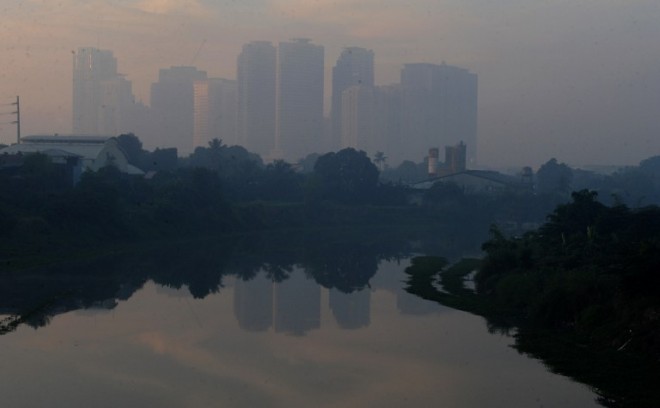What to do after smoke clears to stay safe

A thick blanket of smog covers an eastern section of the Philippine capital Manila on Jan. 1, 2014, the morning after millions across the nation set off firecrackers and pyrotechnics to usher in the New Year. Philippine authorities said more than 260 people had been injured by fireworks or stray bullets in the days leading up to New Year’s Eve. Health authorities advised Filipinos to get rid of leftover firecrackers that children might mistake for food. AFP PHOTO/JAY DIRECTO
MANILA, Philippines—After the smoke clears from the nightlong New Year revelry, make sure to get rid of leftover firecrackers that children might mistake for food. Seek medical help even for small wounds or burns caused by firecrackers. Take it easy on the booze to avoid bangungot.
Anticipating a surge in firecracker-related injuries and other illnesses following the customary New Year merrymaking, the Department of Health (DOH) issued these reminders to the public to prevent further mishaps due to the indiscriminate use of firecrackers and other unhealthy practices.
As of New Year’s Eve, the DOH National Epidemiology Center had logged 176 accidents arising from firecracker use, a figure 42 percent lower than that from the same period last year. At least one injury was caused by a stray bullet.
Too much drinking
Aside from urging merrymakers to be vigilant about firecracker burns and poisoning, acting Health Secretary Janette Garin on Wednesday advised the public to drink moderately to prevent acute pancreatitis, more commonly known as bangungot.
Article continues after this advertisement“It usually occurs among males with a history of too much drinking the day before,” Garin said.
Article continues after this advertisement“This usually creates grave consequences including death,” she added.
In a separate advisory, the health agency also urged revelers with wounds or burns from handling firecrackers to immediately seek medical treatment at the nearest health center or hospital, including antitetanus shots.
“Tetanus is fatal so don’t ignore even minor burns or small wounds caused by fireworks,” the DOH warned about this serious, sometimes fatal, illness caused by the Clostridium bacteria that can affect the nervous system and interfere with one’s ability to breathe.
For firecracker-caused burns and wounds, the health agency advised washing the affected area under clean running water, patting it dry and covering the wound with gauze before seeking medical help.
Poisoning
“Make sure children will not pick up leftover firecrackers,” the health agency further warned, as ingesting them could cause poisoning.
Earlier, Garin said parents and caregivers must be extra-firm in preventing their children from using firecrackers to greet the New Year, and must immediately seize and stow firecrackers in a place inaccessible to children.
With firecrackers sold in colorful and attractive packages, children could easily mistake them for food, which could lead to firecracker poisoning when ingested, the health agency warned.
DOH records from previous New Year festivities showed that majority of cases of firecracker ingestion involved piccolo and watusi, which are both small and colorful.
Two cases of firecracker poisoning caused by a sparkler, popularly known as luces, have also been reported this year.
Raw egg whites
“The piccolo is very poisonous because it contains yellow phosphorous,” said the DOH, adding that 50 to 100 milligrams of the substance can prove lethal to humans. The same substance is found in the watusi.
In case of firecracker ingestion, vomiting must not be induced, said the health agency.
Instead, six to eight raw egg whites should be given to children, and eight to 12 raw egg whites to adults before seeking medical attention. The egg whites are not a cure but will act as temporary protection to the gastrointestinal tract against the damaging effects of the toxic substances, the DOH explained.
For dermal exposure, the patient must bathe using alkaline soap like Perla. “If (the firecracker hits) the eyes, immediately wash them with water for at least 15 minutes. Keep eyelids open [and] seek immediate medical attention,” the health agency added.
Should the contents of a firecracker be inadvertently inhaled, the patient must breathe fresh air and be kept comfortable and warm while urgent medical assistance is sought, the DOH said.
Out of the 176 firecracker-related injuries culled as of Wednesday, 46 percent were reported in Metro Manila. The city of Manila accounted for 38 percent of the cases monitored in Metro Manila.
Piccolo remained the No. 1 culprit, accounting for 122 firecracker-related accidents.
The DOH also recorded the first case of New Year mishap caused by a stray bullet on Wednesday, when a 24-year-old man from Barangay (village) Damayang Lagi in Quezon City sustained a gun wound in his right hand while walking along E. Rodriguez Avenue.
RELATED STORIES
The man who saw blood: Dad hurt by ‘cracker calls for safer New Year revelries
DOH warns those who use firecrackers: No cure for damaged future